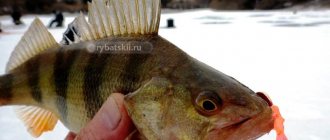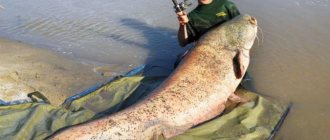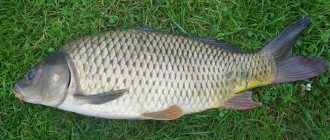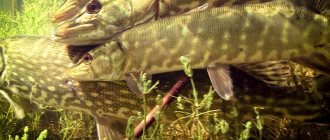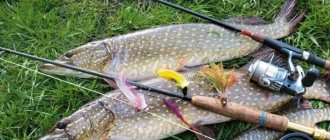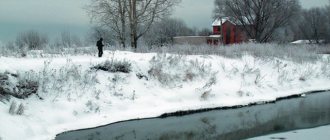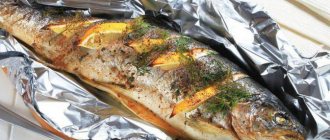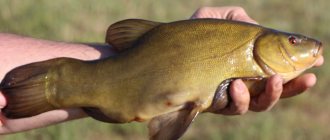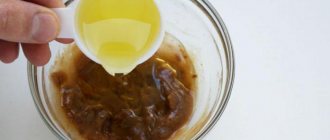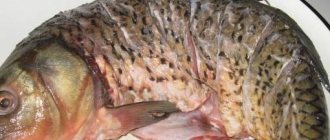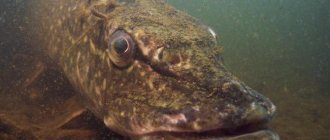Spring has come. Winter gear has already been put away until the next season, and the fisherman’s main task is to find a decent fishing rod, equipment, choose a reservoir and open a new season. To do this, he must have a good understanding of the behavior of fish after wintering, fishing conditions, and the start time of biting.
Let's look at when and at what temperature the following fish begin to bite after winter: carp, pike, bream, carp, roach, catfish, tench, perch.
When does the carp start biting?
The first good speck bite begins 3 – 4 weeks after the ice melts. During this time, the water level in the reservoir stabilizes and the turbidity settles. Carp emerge from wintering pits into shallow water in order to warm up and get enough oxygen. The fish at this time have little interest in searching for food, so you shouldn’t expect a good catch.
The best conditions for carp fishing
- Place . Shallow waters with dense vegetation or holes up to 2–3 meters deep are suitable for carp fishing.
- temperature should warm up to 18 °C.
- Atmosphere pressure . Increasing pressure for several days in a row is the key to a good catch.
- Weather . In early spring, choose sunny, windless, warm days for fishing.
When does carp start biting in ponds?
The ideal time for catching carp on a pond is the end of April , May , when consistently warm weather sets in and the water warms up. After winter, the fish has time to get over the disease and is intensively fattened before the upcoming spawning.
The trick to spring fishing also lies in the fisherman’s caution: before the water has time to bloom, he must behave carefully and not give away in front of the fish. In spring, carp stay at shallow depths, so even shade can scare them away.
Bait
For carp fishing in March and April, the best bait option is bloodworms. At the end of April-May, the diet expands significantly, so the fish actively bite on peas, corn, potatoes, and boilies.
Lure
Carp bait is used to attract fish to the place and get a larger catch .
You can buy it at the store or prepare it yourself. Store-bought mixtures are advantageous in that they are already ready for use, but professional fishermen prefer to use homemade baits that do not use chemicals (boiled and mixed semolina, peas, millet, pearl barley, corn porridge). For greater attractiveness, attractants are used: vanilla, coffee, cocoa, clove syrup.
Features of fishing in spring
The nuances of feeder fishing in the spring largely depend on what kind of fish is biting. Pisces awaken from winter torpor at different times, some earlier, others later. Some feeder fishing gurus insist that with a feeder you catch whatever is at the feeding point. However, strategically, you still need to tune in to a specific species, adjust the feeder equipment and feeding tactics in accordance with the habits of the hunted object.
crucian carp
In the north, crucian carp sleep in the spring almost until May, until it really gets warm. However, in the south and in some places in the middle zone, crucian carp (hybrid, dushman) is active even in winter, especially in rivers. In the spring, during high water, a massive movement of this fish begins into small tributaries of large rivers and reservoirs. With the onset of warmth, crucian carp spawn in shallow, overgrown areas.
The spawning period for crucian carp is extended, with some individuals spawning and others feeding. At this time, the running crucian carp takes on any equipment, mainly on a worm and maggot, but in some places pearl barley and corn work well. You need to work with baits and their aromas, choosing a working option on each fishing trip with a feeder - the tastes of crucian carp are very fickle.
In closed ponds, crucian carp in the spring also begins to peck at a water temperature of 6-7 degrees, at first sluggishly, gradually increasing feeding activity. It is better to catch it in the spring in shallow waters among last year’s reeds, where young shoots begin to emerge. In still water you can catch it with standard feeder rigs or on flats.
The first flat feeder in early spring will most likely bring just some of the hungriest crucian carp, and not carp. We use the same worms or maggots as bait. If we fish with boilies and pellets, preference should be given to meat or fish scents - krill, shrimp, halibut (halibut). As the weather warms up, the sweet fruity flavors of the baits also begin to work.
An article about catching crucian carp with a feeder in the spring.
Roach
The ubiquitous roach can be caught with a feeder in the spring as soon as the ice melts from the reservoir, even in clear water before the flood. Roaches begin to be active in the spring already at 5 degrees. Local roach more often leaves their anchorage points and moves out into the current, under the reeds, where they look for food. To catch it in early spring on a feeder you need to use the thinnest gear, web leashes 0.08-0.1 mm in diameter with small hooks. Each roach eats a couple of larvae and gets full. Therefore, during this period of spring it is important not to overfeed.
With the onset of floods and floods, the roach becomes active and gathers in schools. Large roach from large reservoirs, ram from the Don or roach from the Volga enter the tributaries in huge flocks, rising to the very upper reaches to spawn. During a flood, you can stumble upon a feeding roach with a feeder anywhere except deep holes, but it is difficult to calculate this in advance. If it happens, the catch is guaranteed.
For active fish we use larger baits, 2-3 maggots or in a sandwich with bloodworms. In May, roaches are caught using pearl barley or steamed wheat flavored with vanilla, honey or anise. Spring fishing for roach with a feeder will bring more results if you hunt for this fish purposefully with thin, delicate equipment.
Sometimes it is not feeding that works better, but the reconnaissance tactics of the feeder, as well as provocative twitching and pulling of the equipment. Roach also does not always take from the bottom, preferring a smoothly sinking bait, especially in the current.
Bream
Feeder fishing in spring is also successful for bream. The principles are the same - careful rigging, careful work with bait in cold water and searching for fish during and after a spill. Active fishing for bream begins in places where it is constantly concentrated in the summer, after returning from spawning. However, the sedentary form in lakes, ponds and small rivers can be caught earlier if the location is known.
Bream is not afraid of the cold and feeds all winter. It’s just that during periods of high water, schools of bream leave their permanent habitats and go to spawn in shallow waters or upstream tributaries. Migratory bream can be caught in river channels along its route upstream.
Sometimes schools of bream come out to feed or bask in shallow water, even a meter deep. In order for catching bream on a feeder in the spring to be successful, do not forget about the unshakable principles of bottom fishing - compact feeding, containing in the mixture the same components that are attached to the hook. The bream not only needs to be lured, but also forced to rummage in the ground in search of food. In the spring, running bream, like roach, may not take from the bottom, but grab the submerging bait right away.
Read more about fishing with a helicopter rig.
Carp and carp
Carp in the ponds are gradually becoming more active. If you try, you can catch it in early spring. More likely, he will react to a bunch of worms or boilies, pellets with meat odors. You should try to catch in stable warm weather in warm areas rich in young reeds - in the same place as crucian carp. As the water warms, the carp becomes more active and begins to feed intensively - then all summer methods already work. An article about spring carp fishing on a feeder.
Spring fishing on a feeder on a river in the southern regions usually occurs in anticipation of a bite of carp or fish against the general background of crucian carp (from April and later). Everyone is already quite fed up with the ubiquitous crucian carp, however, when catching it in rivers, sometimes decent-sized carp fly onto the feeder. If you are sure that the carp will appear here, then you can sit purposefully on it.
You can fight off crucian carp bites by using larger baits, boilies or pellets. However, in the spring, in the rivers, the carp is best caught on a large bunch of worms - dung, rain or crawling worms. At times, bites also occur on corn, especially in tandem with maggots.
Subscribe to the channel:
YouTube channel RYBAFAN
We are VKontakte
Pike – when it starts to bite after spawning
The post-spawning pike bite begins in mid-March and can last until mid-May. At this time, the fish actively rushes to most baits:
- wobblers;
- rotating spoons;
- vibrators;
- spinnerbaits;
- silicone and foam baits;
- for live bait (small perch, sprat).
When using bait as bait, it is important to place the bait on the hook correctly because the fish must remain as active as possible to attract the predator. The best option for fishing on the river is to hook it through the gills or on the upper lip. While fishing on the lake, he gets pierced in the back.
Optimal time for fishing with spinning rods and lures
For a big catch, you need to go out on the water in the morning: from 7 to 10 o’clock or in the afternoon - after 16.00. Early in the morning and late in the evening, pike do not hunt as the water temperature drops. If precipitation begins, low clouds and a drop in air temperature, the pike stops biting altogether.
On reservoirs, shallow places with preserved last year’s vegetation are selected.
Spinning fishing from the shore.
To catch pike from the shore, you need a rod no longer than 2.7 m with a weight of up to 20 grams.
River pike differs from lake pike: it is more energetic, so in the first case, active wiring is used. Fishing from the shore involves changing places as quickly as possible. If after 10-15 casts the fish does not respond, you should immediately change the point.
Lure fishing.
The most suitable option for casting a spinner: pendulum or side. So the bait flies a short distance. Vertical whip casting is possible in the absence of tree branches or bushes.
The movement of the spinner should be uniform, slow or at medium speed. On the edges bordering the shallows, step jigs are used.
Features of float fishing in spring
Those who are accustomed to opening the season in early spring know very well that the main difficulty of such fishing is the high water level in rivers and lakes. The reason for this is melting snow and frequent spring rains. Therefore, a great option for such fishing is a boat. But first you need to find out whether there is a ban on it during this period in your region due to fish spawning. Often in spring, restrictions apply even to wading, but you are allowed to use a regular fishing rod and one hook. You can read more about the timing of the spawning ban by region here.
Be ready to experiment. After all, the behavior of fish at this time, like the weather, is unstable. Strong winds, atmospheric pressure, precipitation, etc. greatly affect underwater inhabitants. Therefore, you will have to make frequent recasts, change baits and look for new promising places until you catch the coveted trophy.
If we talk about baits, then for spring fishing it is best to use nutritious baits of animal origin (maggots, worms and bloodworms). After winter, aquatic inhabitants strive to replenish their reserves and begin to prepare for the upcoming spawning, which takes a lot of strength and energy from them. That is why animal baits will come in handy.
You need to feed the fish carefully at the beginning of the season. It is better to use fine-grained mixtures designed for cold water. They perfectly hold the fish at the fishing point without saturating it. Please note that strong aromas can scare away aquatic inhabitants, so opt for less pungent odors.
Bream
Bream quickly reacts to the onset of spring and as soon as the water warms up to 5-10 ° C , it begins to feed.
Moreover, the cleaner the water, the more active the fish. With the onset of warmth, bream leaves their wintering pits and moves closer to the shore to a depth of no more than 5 meters . The reason for this is the increase in water temperature, its enrichment with oxygen and the presence of food brought by the flood. The most successful places for catching bream on a feeder are shallow areas of a reservoir with an uneven bottom. You should look for it along the edges or near old reeds.
On the river, schools of bream can be found on the edges of the riverbed or in shallow water near them. Promising places are under steep banks near pools, without dense vegetation.
When can you start fishing with a feeder?
The main task of a fisherman when catching bream on a feeder is to get to the pre-spawning feast, when the fish gather in schools for active feeding.
In May, during spawning, bream moves to bays and river mouths; you can also find them near dams.
early spring, fishing on the feeder is possible throughout the daylight hours. From May you can go out on the water throughout the day, and at night the bream comes closer to the shore to feed.
Features of fish behavior
If feeder fishing in early spring is designed mainly for roach and bream, which are already quite active during this period, then with warming all fish (except for burbot) become more active. There is no exact recipe for the bite - each area has its own schedule, which also depends on the weather conditions of spring.
In each specific area, you need to focus not on some general biting schedules, but on weather conditions and the degree of development of spring changes in reservoirs. When in the south they are already catching crucian carp and carp going up in full force, in the north some reservoirs are still covered with ice. Therefore, the division of feeder fishing into March, April and May is very arbitrary.
It all depends on the onset of heat and the general transition of nature from winter to summer. When can you fish with a feeder in the spring? At any time in spring, if there is open water and the ability to get to the reservoir along muddy roads. Depending on the period of nature’s transition from winter to summer, the features of spring fishing will differ.
The feeder is a universal tool; you can fish with it both when the fish are hungry and during periods of inactivity of the fish in early spring. The gear is the same - the fishing spots are different. Feeder equipment, bait, baits and fishing tactics also differ.
Feeder in early spring
Immediately after the appearance of open water, if it is not a sharp break in the shell and ice drift (usually this happens on large rivers), at such points you can already fish with a feeder. In spring, thawed patches gradually begin to appear in small rivers, on currents and riffles, as well as in areas with springs and warm runoff. Fishing with a feeder also continues on canals and rivers that do not freeze in winter. After the ice melts, until active warming and rising water begin, the temperature in the reservoir is low, about 4 degrees.
When the water warms slightly to 5-6 degrees, roach and ide begin to become active. The fisherman (syrty) may already be in small rivers at this time - this fish sometimes migrates to spawn under the ice, and during the period of active fishing in high water it already descends back (in the south). Fish begin to emerge from wintering pits into warmer shallow water areas more and more often and farther away. By spring, migrating fish from large rivers and reservoirs gather at the mouths or lower reaches of tributaries, into which they will flow as the water rises.
The feeder in the spring begins with catching roach, bream or bream, which, although not yet fully active, are still feeding. The water temperature is low and the fish's metabolism has not yet recovered from its winter slow state. This type of feeder fishing takes place according to the winter scenario. The fish needs very little to get enough.
Therefore, when fishing on a feeder in early spring, the bait should be finely dispersed and non-nutritious, so as not to saturate the fish, but only collect it with smell and turbidity. Be sure to add food bloodworms, crushed worms or maggots - but not much, so as not to feed the possibly small amount of fish that arrives at the feeding point.
You can start fishing with a feeder in the spring in these areas that are already free of ice. Usually these are currents and ducts. We don’t climb into the rapids itself – there are no fish there yet. The best points for a feeder are places with flow near holes with a depth of 2-5 meters, deep turns and clearings under the shore, places where streams mix and where the return flow connects to the direct direction of flow.
The approach to bottom sounding is standard - we look for underwater anomalies, edges, areas with last year's vegetation on the bottom, shell rocks, scatterings of pebbles among sand or hard areas among silt.
This passive behavior of fish in the spring continues for about two weeks after the ice melts. As soon as the temperature begins to rise and the river becomes cloudy in anticipation of the rise in level, everything in the reservoir wakes up to a feeling of spring. If in clean, shallow water small baits worked better - one maggot or bloodworm, then as warmer weather approaches, the fish begins to feed more actively.
Fishing with a feeder in early spring in the river after the ice has melted - carefully hatching sluggish roach or bream. With warming, fishing turns into a lottery. Yesterday there was silence - but today, with the flow of water, the fish are in full swing, rising up. Activation also occurs in the local sedentary population, which does not go anywhere. In the southern regions, at the end of March, the flood is usually in full swing, crucian carp, carp and shemaya wake up, and fish and fish catch on the stream.
Provocations help to stir up passive fish with a feeder - tapping different parts of the day, pulling within the boundaries of the feeding spot, fishing downstream. Sometimes feeding a point in the spring does not bring results - the fish is somewhere else, but does not come out to feed. Some fishermen use active search tactics, throwing the feeder for 10-15 minutes at various points, and begin feeding in places where there were bites.
Feeder in April
The feeder on the river in the spring, as the water begins to rise, begins to have a different character. The fish goes up, entering tributaries. Deep-water pits do not work in spring - it is better to look somewhere smaller, near bushes, in flooded meadows and their border with the main channel. At the beginning of the spill, you can also fish with a feeder on the riverbed, at depths of no more than 4-5 meters based on passing fish.
When the water warms up to 10 degrees, the bulk of the underwater inhabitants are already actively feeding. Migratory fish move stronger every day, stopping in secluded places and continuing to actively feed. Fishing with a feeder in the spring in muddy water for active fish makes delicate equipment unnecessary. The bites are usually bold and powerful; she does not notice thicker leashes in such conditions.
When the flood is in full swing, you need to fish with a feeder in shallow warm places, in shallows and flooded meadows without writhing, with small green grass at the bottom. When the water warms up to 15 degrees, the bite is active - the main thing is to find fish. At this time he can use any equipment. Natural baits work better - bloodworms, maggots, worms, and in some places corn.
In muddy water in the spring, the fish clearly sees the yellow color, and therefore attacks the corn. The bite on the feeder usually continues at some intervals throughout the daylight hours. At this time, you can catch anyone on the river with a feeder in the spring, including fish, which are not there at all in the summer.
The main thing is not to be afraid to experiment with the feeder. There is no need to sit and stare at the quivertip if it doesn’t bite for a long time. We change the distance, baits, leash length - the main thing is to find the keys to the fish. In spring, in rivers, it is often not fishing from the bottom that works well, but dropping bait on long leashes with a helicopter or paternoster rig. At this time, even bream may prefer to take a falling bait, and roach, bluefish, saberfish or ide - even more so.
Ponds and enclosed reservoirs are cleared of ice later; there is no spill in them as such. The main factor is water temperature. Waking crucian carp and crucian carp in the spring subtly react to any temperature changes. For example, in calm sunny weather there can be an excellent bite in the shallows, at the edge of the vegetation. But if the wind starts and mixes warm water with cold, the bite may stop. The bite in ponds increases gradually as the weather gets warmer. Read more about feeder fishing in April.
Feeder fishing in May
In some regions in May the flood is only gaining momentum, while in others the rivers return to the banks. The water is getting warmer, brighter, the fish are returning to their summer habitats and actively feeding. In May everything and everywhere bites. In many regions there is a spawning ban at this time. You can fish with one tackle with one hook. For the feeder, this is a golden time - the main thing is to release species that are prohibited from catching - vimba, shemai, sturgeon (requirements differ in different regions).
Spring feeder fishing smoothly transitions into summer, massive feeds and sweet fruit aromas and plant baits begin to work. As a result of the final clearing of the water, restoration of the level and the onset of warmth, the fish occupy summer quarters. The full range of feeder capabilities opens up in any reservoir. In large rivers, with the right approach to the feeder, bream begins to be caught in the usual places, ponds and reservoirs work.
Fishing with a feeder in the spring on the river - standard tactics, feeding and experimenting with baits and leash length. In stagnant reservoirs in the spring we look for crucian carp, carp or carp in shallow waters where reeds begin to sprout. Feeder in May - full-fledged summer fishing using the maximum capabilities of the gear, both in still water and in the current.
Roach
In spring, roaches are most indiscriminate in food and are most active due to the feeding that precedes and ends spawning. After the water opens from ice and saturates it with oxygen, the fish moves around the reservoir in search of food. At this time, it “responds” best to natural baits offered by the fisherman:
- maggot;
- bloodworm;
- worms;
- burdock larva.
When the water in the river warms up to 10° C, the fish begins spawning, after which it “gets sick” for about 14 days. At this time, it is almost impossible to catch roach.
Then the roach goes out again to search for food and you can catch it until the fall. The only exception is very hot summer days, when it goes to greater depths.
The beginning of roach fishing after winter on the river and with a fishing rod
For spring fishing for roach with a fishing rod on the river , the quietest bays are selected, in which the depth does not exceed 3 meters.
You need to work areas near reeds and abundantly overgrown with grass. The main diet of roach is localized here, so such areas are often abundant in fish. If a fisherman chooses a place on the current , then you need to use the appropriate equipment: heavy weights and floats to facilitate long-distance casting.
On the river, it is also necessary to use fertilizer, which, in addition to dry biscuits and breadcrumbs (for example), should also include an animal component: bloodworms, maggots. Feeding is done at the rate of 1-2 balls for 30 minutes. It is not worth feeding often and a lot in the spring - this worsens the bite, because the fish quickly becomes saturated.
In order for the fish to react better to the bait, the maggot should be placed on the hook not with a stocking, but across it so that it moves.
Fisherman's calendar for March
In March, the long and cold winter with its snowstorms, frosts and short days ends. The long-awaited spring is coming, but in March it has not yet fully arrived. There is still snow on the fields and in the forest, although the first thawed patches are already appearing. And the reservoirs are still covered with ice, but the rivers are awaiting ice drift.
In March, winter seems to be fighting with spring and does not want to give in to it. The old woman-winter sometimes gets so furious that a blizzard swirls like a winter, cruel and strong, and in the morning there is frost that stings the nose and cheeks. But nevertheless, there are more and more warm and fine days. The sun is shining brighter, melting snow and ice with its rays.
Melt water forms streams, they make their way through the ice shell of reservoirs. As a result, rivers and lakes are saturated with oxygen, which is so necessary for aquatic inhabitants. Roach, perch and pike emerge from their hiding places, dramatically changing the picture of the kingdom of the depths of rivers and lakes. The fish, hungry during the period of loss of appetite in the dead of winter, begins to scour the reservoir in search of food.
In March, many species of fish greedily grab any bait on a jig or hook. In the first month of spring, at shallow and medium depths, predators are caught using spoons, girders and jigs. In clear weather it is better to use dull spinners, and at dawn - bright silver-plated ones made of nickel. At this time, pike roam the pond in schools.
In spring, pikes wake up and actively bite
Therefore, fishermen can catch more than one toothfish. Burbot is a nocturnal predator, but sometimes in March you can even catch it during daytime fishing. At night they set donks on burbots, using gudgeon or ruffe as bait, and in the morning they check whether they have caught a fish with the appearance of a snake.
While there is no ice drift, fishermen fish with winter fishing rods with a float or nod. This month they are biting well on worms, bloodworms and maggots. As long as there is no clouding of the water that is dangerous to the health of the fisherman, roach, perch, chubs, and roaches are successfully caught. The fish bite very well on the last ice, because this is no longer the dead winter.
They fish not only with jigs, but also with small spinners. In a calm current at a depth of three to five meters, pike, chub, and ide take well. From the middle of the month it begins to catch well not only on rivers, but also on lakes and reservoirs. Slow-flowing reservoirs are considered the most productive.
But in lakes where rivers do not flow, the fish bite worse this month. You should watch for changes in air pressure and other vagaries of the weather, which greatly affect the fish bite. When there is a sudden change in weather, for example, when after a severe frost there is a sudden thaw, the pecking stops completely.
On such days, fishermen usually stay at home so as not to spoil their mood with the almost complete absence of bites. But for those fans of ice fishing who consider the process of catching fish more important than the weight of the catch, no amount of bad weather matters. You should remember about safety when entering the last ice.
Life is more important than catch, so even with an excellent bite, you should avoid places near gullies and ice holes. It happens that in the morning it was easy to walk on ice in the frost, but in the afternoon the sun became so warm that returning to the shore in the evening becomes difficult.
Therefore, you should not go fishing on the last ice alone. If the ice seems suspicious, it is better not to go there. At this point, the fisherman’s calendar for March can be considered closed, let’s move on to April.
Fishing on the last ice is very dangerous, so fishermen should not be on the reservoir alone
Bleak
You can go fishing for bleak at any time of the year.
From early spring it is extremely active, quickly responding to the offered bait. After the water has warmed up to 6°C, the most intense bite begins. Bleak reproduces quickly and lives in large flocks. Places at river mouths where large amounts of food accumulate are suitable for catching bleak. Lures for March bleak:
- maggot;
- miniature pieces of lard;
- bloodworm.
You need to attach the bait so that the tip of the hook comes out - this will not allow the fish to get away.
It is important to choose the right hooks, sinkers and floats (sensitive). There is no need to save money; it is better to choose quality material. In April, bleak enters coastal waters and is most active in the morning from 6 to 10.00 and in the evening from 17 to 20.00.
During the day the bite is not excluded, but it is not so intense. You can improve the bleak bite by feeding it. In May, you need to look for bleak at a depth of up to 1.5 meters in bays, shallows, and in places where there is a rip current. Often the fish feeds almost at the very edge of the water, without sinking to the bottom.
For May, the ideal bait is:
- bloodworm;
- bread balls;
- maggot;
- dough with added vanilla.
Hint for beginners: you can determine the location of the bleak by the circles and bubbles that the fish leave behind.
Tackle for spring fishing
If the fish has begun its spring run and has an active pre-spawning feeding, then it can be caught using many tackles, such as spinning rods, bottom and float rods. The most commonly used fishing rods are float rods; they can be used for fishing from early spring until late autumn. But you shouldn’t fish with a big hook and a thick line, everything should be in moderation. A thick fishing line will not scare away a predator, because it will be mistaken for plant stems and branches, it floats strongly and this makes the equipment less stable. But it is advisable not to use thin fishing line due to the risk of frequent snags and breaks, with constant tying of the equipment. The most optimal fishing line will be approximately 0.12 mm in diameter; this strength will be enough to pull out not only a large predator, but even a solid snag.
The length of the leash when fishing in early spring depends on the speed of the current, the weight of the equipment, the type of fishing and the frequency of biting. Follow the general rules; if the bait is eaten and there is no bite, reduce the length of the leash. Increase the length if you were unable to hook with visible bites. The length of the leash varies from 5-20 cm.
We choose a stable float; a teardrop-shaped float with a heavy, long keel would be good. They are good for fishing on ponds, reservoirs, lakes where there is standing water. In fast currents, a float in the form of a ball with a through hole, without a keel, is well suited.
It is advisable to select the weight according to the color of the bottom of the reservoir where you will catch the predator. The best option is to attach a pad weighing from 0.05 to 0.5 g. and sinker. The catcher is attached to the main line behind the leash attachment, and the main sinker is 10-40 cm higher from the hook.
Tench
Fishing for tench greatly depends on the regional climate; we will look at specific places.
Lin in the Moscow region
In the Moscow region, you should go fishing for tench in April-May . After winter fasting, the tench's appetite grows and the fish becomes most active in mid-spring. It is at this time that you need to go out with a fishing rod for this fish. Tench responds to worms, bloodworms, various larvae, insects, and algae shoots.
From mid-April, tench enter shallow water. As soon as the water warms up enough, the fish goes to depth, where it behaves cautiously and finicky.
To attract tench to a place, you should feed it. Tench's eyesight is poor, but it senses smells well, so the feeding of boiled millet must include live maggots, chopped worms and, as a delicacy, crushed snails.
Tench in Belarus
Spring fishing for tench in Belarus falls at the end of May. The fish that have just spawned begin to eat. The best time for biting is before dawn and after sunset, especially if the weather is cloudy but warm. Fishing with a float rod with dough, worms, and maggots as bait will give an excellent catch. You need to be located in river backwaters, quarries with a muddy bottom, and overgrown ponds.
Lin in the South
The first access to tench can be as soon as the water temperature warms up to 15°C . After a few days, the fish begin to spawn and by mid-to-late May the tench begins to look for food again. At this time, it is caught at a depth of 5-6 meters from a boat.
Use vegetation as bait: shoots of sedge, reed, egg capsules, young reeds. The stem of the plant is cleaned, thinly sliced to 1 cm in length and put on the hook as a “stocking”, covering the sting. Tench is a very cautious fish: when it feels a prick in its lip, it will immediately throw the bait.
Spring on small rivers
Photo by the author
When spring fishing on small rivers, there are many nuances that the angler needs to know. It is important to correctly determine the place where fish accumulate and choose the right tackle and bait.
On many small rivers, fishing with wires can be successful in early spring. On most rivers in Central Russia, the ice disappears already at the end of February - beginning of March. Of course, it all depends on when the long-awaited spring warmth has arrived. Small rivers are most often tributaries of large and medium-sized rivers. In spring, fish migrate, rising from larger to smaller rivers.
Fishing Features
The amount of fish in a particular place is affected by the flood of the river into which the tributary flows this season. It happens that the flood is low, when the water in the main river rises no more than 2-3 m. Then the fish that enter the tributary usually stay in the riverbed and do not always rise high along the river. Accordingly, fishing tactics should be based on casting to the channel edge or on watering points located at a distance from the shore. Also, during such periods, a lot of different fish gather at the mouth of the tributary in areas of clean, unturbid water.
Fishing on the river is conventionally divided into the period of rising water and the period of declining water. There is a period when the water level fluctuates: it sometimes decreases, sometimes it rises. Floods are very sensitive to rain and air temperature. If the weather is hot, the ground quickly warms up and releases the frozen water in it; accordingly, there is a sharp influx of water even when the flood subsides. Naturally, heavy rains significantly increase the water level. This is where the river level fluctuates.
If the water decline on the main river is slow, the fish bite in flood meadows, bays, and tributaries can last a week. And when the water subsides quickly, the active bite lasts a day or two, and then the fish goes back to the riverbed. Hence the conclusion: the slower the level drops, the longer the bite. When the water rises, the fish press closer to the banks, often coming out to the shallows, and when the water falls, they move to the depths and move closer to the riverbed.
In hollow water in tributaries and in places flooded with rising water, roach, bream, bream, chub, ide, dace, and sometimes silver bream and blue bream actively peck at the worm. Silver crucian carp rises from the depths into shallow water.
Fishing tactics during this period consist of searching for places where fish are concentrated or waiting for them in passing places. In spring, large bream, roach, chub, and ide move around a lot for various reasons. They have their own specific paths on the floods. When the flood waters have spilled over the floodplain meadows through which tributaries flow and flow into the river, fish often come out in schools to areas of calm, clean water that are located above the shore. These can be ravines, areas of flooded forest, meadows and other areas where you can find places convenient for fishing.
If the water has not overflowed much or is already on the decline, then the fish moves along a narrow strip near the shore, where it is not carried away by the current. In places where the passage of fish is detected, it is caught. True, the bite here is not always fast. The fish can bite once every half hour, but the trophies, as a rule, come across decent ones - up to a kilogram or more.
Walking fishing
In spring, fishing with a float rod is popular. When the trees are not yet covered with leaves, the river is clearly visible. You can navigate by the bends of the river, coastal algae and coastal soil to find areas suitable for fishing. Many river tributaries are rich in riffles, holes, dams, channel narrowings and expansions, in front of which a wide variety of fish can stand. It must be taken into account that food dragging along the bottom is carried to calm water. Such areas primarily attract various white fish. They are often found behind capes, spits, and sharp turns. In addition, the fish finds food at the beginning and end of shallow holes following the shallow riffle. All this and other nuances must be taken into account when fishing with a wire rod.
In special areas
Since the river is rich in riffles, holes, dams, channel narrowings and expansions, it is easy to calculate the “points” of fish exit. Despite the fact that chub, bream, silver carp, and roach living in many rivers are not afraid of strong currents, when going out to feed, they will avoid standing on it for a long time. These fish often watch for food floating with the current, hiding behind some kind of shelter. For example, there are plenty of such places on the dammed Lopasna (in its lower reaches) or on Pakhra. Here, the strong current often gets in the way of trees, snags, boulders, and rocky ridges that have fallen into the water.
Usually they fish by wire at depths of 2-4 m, placing the bait in areas where water-dwelling organisms are most often found: along algae, over rocky ridges, near snags, near old piles. In addition, when fishing in mid-water and on top, you need to take into account that insects and their larvae that come to life in the spring sun most often end up in the water where there are thickets of trees and bushes along the banks. The equipment is often used “blind”. The float test and model are highly dependent on the fishing depth and the strength of the current. In the spring, the fish take quite actively, so floats designed for a load of 1.5-2.5 g are quite suitable. Usually, when going to the river, they take two wire fishing rods with them. One is used for catching large fish - bream, chub, solid roach, the other - for catching minnows, bleak, roach, perch. The first fishing rod is equipped with a main line with a diameter of 0.18 mm and a leader of 0.16 mm, the second - with 0.14 and 0.12 mm, respectively. To catch small fish, thinner lines could be used, but on some rivers there are many snags. The float on both fishing rods is replaceable. It is attached with a tiny carabiner to a loop made of soft wire folded in half - it stops the cambric. The latter moves slowly along the line.
Fishing rod rig
For spring fishing on small rivers for fish such as roach, ide, silver bream, white bream, silver carp, chub, you usually need simple equipment: a 5-6 m rod with a small spinning reel on which a line with a diameter of 0.14-0.18 mm is wound with a leash of 0.12-0.16 mm, depending on the size of the expected fish. A properly loaded float with a carrying capacity of 1 to 3.5 g is required. Hook No. 12-18. Larger hooks are used for worm fishing.
Usually, only one weight is used as a load, moved close to the leash. With the help of such equipment, it is possible to fish sections of the river accessible for casting from the bank, without fear of snags and hoping to catch a large fish. Nozzles of animal origin are used.
It is also necessary to take into account that the larger the nozzle, the more load-bearing the float should be. Many fish, such as roach, silver bream, white bream, ide, bluegill, and podust bite well both in direct swimming and with bait stops. But for each type of fish it is important to choose the appropriate fishing speed. For example, ide most often feeds 5-10 cm from the bottom and tries a fast-moving bait. But sometimes it is not so active, and then fishing will require heavier equipment, which can be used to slow down appropriately. In this case, it will be necessary to select a float with a higher test.
Alexey Khludov April 9, 2015 at 06:04
Som
When does it start to bite in the spring?
Around mid-April, when the water temperature warms up to 9-11° , catfish begin to emerge from hibernation in search of food.
He is in no hurry to get out of the pits, so you need to look for him on a boat near his wintering grounds. After the water temperature reaches 12-15°, zhor begins (beginning of May). The catfish, whose metabolism has increased, needs more and more food, so it moves throughout the reservoir in search of food. Small individuals at this time can go out into shallow water, and larger specimens are on reaches where the current is not strong, feeding on shells.
When the water heats up to 19° , the catfish goes to spawn and does not show activity until the end of May.
When catching catfish, fishermen use donks and spinning rods . As bait for donks, they use a small worm, planting several of them, a shell (without shell), and live bait (it is better to trim the fins). For spinning, silicone baits, edible rubber, and spinners are used. Fragrances are not used as they may repel catfish.
Perch
There are only two moments in the life of a perch when catching it is problematic: two weeks of spawning and a week after the ice melts from the reservoir.
The rest of the time it feeds well and is successfully caught using various tackles. The post-spawning feast of the perch coincides with the shedding of the rosehip color and lasts about a week. After this, he goes to his summer camps, where he remains until the fall.
In early spring , young perch approach the shore in search of food (spawning fish eggs). Larger individuals reach the coastal zone two weeks later, so they are caught at long distances.
Having spawned , the perch remains near the shore for some time, chasing the fry. At this time, he is caught using a spinning rod and a float.
The best places for fishing : flooded trees, bushes, river backwaters, areas with slow currents, boulders.
When does the perch start biting on a spinning rod?
In spring, the water is still cloudy, so baits need to be selected in bright, acidic colors.
The best option for spring: wobblers, spinners, silicone baits. As soon as the haze subsides, you should switch to natural colors with a bright point of attack. Searching for perch begins with the use of spinners, which must be carried out as close to the bottom as possible. If there is no reaction to the turntable, a jig head is placed, with which the bottom topography is studied. After this, a wobbler with a depth of at least 1.5 m is used, because perch does not bite in the upper layers in the spring.
Spinning rods for catching perch should not be particularly large. Perfect for 2-2.5 m long with dough up to 15 grams and fast action. The reel should also be light, and the spool size should not exceed 2000.
The rod is equipped with fluorocarbon, monofilament or braided thread (if fishing is planned along the shore). A shock leader is used to prevent the cord from fraying.
Fishing with a float
For catching perch with a telescopic fishing rod, a light rod with a length of 4 to 6 m is suitable. The reel should be equipped with a fishing line with a tensile load of 2-3 kg. There is no fundamental difference in the choice of float. Correct shipping is important.
The size of the hook must match the bait so that the perch does not escape. It is better to bait with maggots, bloodworms, worms, or a miniature silicone twister.
The main rule of perch fishing: short runs with constant play of the bait. To do this, the tackle constantly rises and falls, thereby attracting a predator.
Rotan
You can find rotan in ponds and lakes. Spring rotan prefers to stay closer to the shore and often trophy specimens can be caught at a depth of up to 1 m .
Rotan is not a schooling fish, so catching more than three individuals from one place is problematic. The fish’s favorite place is coastal areas littered with branches and reeds, at a depth of up to 3 meters.
After casting the bait and there are no bites, you need to move the rod - this will attract the attention of the rotan. There is no need to hook the fish. If the float moves or sinks noticeably, it means it is on the hook, and sometimes it has to be cut off, since the rotan swallows it very deeply.
The best time for fishing in spring is early morning. Small spoons up to 3 cm and bait are used: worm, lard, fresh meat. The equipment is weighted with a sinker.
It is important to know that it is impossible to find rotan in reservoirs where there are pike and perch, since predators completely exterminate its population.
What fish to catch in spring?
In the spring, humpback perch, large ruff, good roach, trophy bream, and ide are also well caught. And this is not a complete list of fish that can be caught.
Also, do not forget that ice in spring is very dangerous. Above-zero temperatures, sun, rain and fog gradually corrode the ice shell. The ice becomes very loose. It is especially dangerous where there is a current. Under even-looking ice, a gulley is sometimes hidden. Ice breaks unexpectedly, without warning. Therefore, it is better to go out on the ice together, or with various devices that will help you escape and not drown. Very often, such troubles await the unlucky fisherman in the evening.
When he returns home, approaching the shore, he sees that he is cut off by a wide ravine. Sometimes you have to swim. So spring fishing is very tempting and dangerous.
When spring ice fishing enthusiasts are working on holes, risking falling through the ice, summer fishing enthusiasts are rushing to clean water. At this time, they also have a very high chance of catching a good catch.
Carp
In Russia, carp begin to bite in late May - early June, depending on the luck of the year and specific regions.
Fishing in Astrakhan
In the spring in Astrakhan you need to go fishing for carp from mid-April.
At this time, the fish comes out of the holes and rushes to shallow water in search of food. The largest individuals (up to 30 kg in weight and up to 1 m in length) are caught in the dark, both from the shore and from a boat. Carp loves places with slow flows, edges, snags, steep banks, river bays, and the edges of river thickets. Also, one of the conditions is the nature of the bottom: it must be muddy.
When fishing for carp, the rod should be replaced with hooks, elastic bands, and a feeder. Edible and artificial bait, as well as boilies, are used as bait. The catch of carp will increase significantly if you feed it during the fishing process (corn, beans, soybeans, potatoes, boiled and mixed with the soil of the reservoir).
If a fisherman chooses a fishing rod, then its test weight should not be less than 90 g, and the length of the line on the reel should be up to 150 m - this will allow you to make long casts.
The secret to successful carp fishing is the use of pheromone baits, which stimulate hunger, attracting whole schools of fish to one place.
Silver carp fish
In early spring, silver carp are inactive , feed near the bottom of the reservoir and do not come to the surface.
The fishermen's task becomes easier in April, when the water warms up enough and the fish come out to bask. You can often see splashes - this is a heat-loving silver carp jumping out. The fish come closer to the shore in windy weather , when food is blown off the land. So, in places with fallen vegetation you can catch a trophy specimen. The spring feeding of silver carp lasts until the end of May - beginning of June, when its spawning begins. In the post-spawning period, zhor resumes. The fish actively go for natural baits: insects, vegetation, fruits, grains.
Fishing in spring on ponds
To successfully fish for silver carp on ponds, select the appropriate gear:
- bottom;
- float;
- for technoplankton.
During cloudy weather, silver carp sink to the bottom in drifts and snags, so fishing with a bottom will be relevant. Float tackle will help you catch fish in clear weather in shallows no more than 3 m deep.
A trick for a fisherman: if you can’t visually determine the location of the fish, just hit the water with an oar: the frightened fish will give itself away.
Secrets of catching different types of fish
With the onset of spring, fish are very cautious and careful, so they should be caught in places where there is aquatic vegetation, submerged bushes, etc. The wiring should not exceed a length of 20 m. In places with heavily overgrown banks, it can be only 4-5 m length. During wiring, it is recommended to sometimes play with the bait. In addition, you need to hold the advance of the float so that the nozzle is above the ground. Even at this time there are sometimes bites. The hook is released just above the bottom. But the fish prefer a rolling bait. Taking into account differences in depth, the float must be set so that when the depth decreases, the nozzle passes above the very bottom, and, conversely, when it increases, it slightly touches the bottom. The nozzle is placed along the stream or close to it.
To attract fish, experienced fishermen advise placing brightly colored beads on the edge of the hook.
For those who like to fish for roach, you should look for grassy lagoons, which are located near currents and grassy channels. In this case, the nozzle is carried along the window. This type of fishing can be done with or without wiring. Shallow riffles with rocky ridges and soft silted soil are another place where roaches like to huddle. For bait use bloodworms or red worms. The nozzle is placed at a depth of 10-15 cm from the bottom of the reservoir. The roach simply swoops down on this delicacy and immediately makes itself known. It is very important to show dexterity here, because the float immediately sinks to the bottom, so you need to make the hook in time.
Spring mix
The main accumulation of bream can be observed near the mouths of rivers, in places where there are deep riffles. Most often, he waits for food at the border of the river. Just like the silver bream and blue bream, this fish settles near steep banks, in the depths of riffles and channel edges.
As for the chub, this fish is very picky in terms of shelter. In places where there are flooded bushes and there is a small island of quicksand across the channel, the chub will most likely give preference to the second place. After all, it is here that an abundance of food and a good current await him. In addition, such places are considered safer. Large concentrations of chub can be observed near islands and spits, if there are any in the reservoir.
This is the best place to wait for food to be carried away by the current. This fish is caught on the surface, half-water and from the bottom. If wiring is carried out on the surface, then use a transparent float in the form of a ball, which should be half filled with water. Such a float is ideal for catching this fish, since it is characterized by a sharp bite.
Massive concentrations of bleak are concentrated in quiet places and nooks, close to the main current. If such a site is found, then the concentration of bleak can be significantly increased by lowering a fine net with breadcrumbs to the flow boundary.
Pike in the spring has two feeding periods - one before spawning, almost under the ice. During spawning, the predator, like pike perch, catfish and burbot, loses interest in food and does not respond to even the most tempting baits. But at the end of April, a frantic post-spawning frenzy begins, when the pike rushes at any moving object. That’s when spinners, wobblers and other tricks come in handy. But the best thing is to prepare high-quality live bait.
From mid-May, real fishing begins - bream, white bream, carp, asp and other fish join in.
Pike-perch goes well with spinners in spring Spring burbot First catch - large roach
